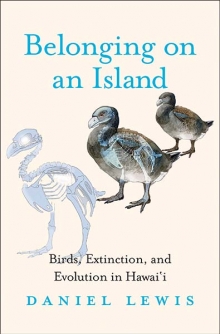Author Interview: Daniel Lewis
/Daniel Lewis, Dibner Senior Curator for the History of Science and Technology at the Huntington Library, writes in his new book Belonging on an Island: Birds, Extinction, and Evolution in Hawai'i about the natural history of Hawaii's beautiful and exotic birds – but also about the whole concept of indigenous species, 'invasive' species, and the nature of wildlife adaptation. Lewis recently talked with Open Letters:
Open Letters: Thanks for talking with us, and congratulations on the utterly fascinating book! In Belonging on an Island, you mention that millions of tourists to Hawai'i every year have no idea they're admiring non-native flora and fauna -- what led you to take a closer look at the life of the islands?
Daniel Lewis: Well, I was born and raised in Hawaii, and like so many others – both people living there as well as visitors – I had no idea that so much of what we ate, saw, and experienced came from other lands. Researching the book was eye-opening. Mangoes? Imported from Manila in 1824. Pineapples? Introduced from South America. Grapes? Likely brought by Captain Vancouver in 1792. Plumerias, ubiquitous in the islands, came via a German physician who moved there in the mid-1850s. Even the name “lava” is from somewhere else – it’s an Italian word!
OL: That natural reality you're describing sounds like carnage for native species, but your book takes a broader and more complicated view of the matter. How exactly would you describe an "invasive species"?
DL: Ahh, now we get down to brass tacks! Although I take issue with the militarized term “invasive” (see this recent letter the New Yorker published of mine a few weeks ago: https://www.newyorker.com/magazine/2018/03/26/letters-from-the-march-26-2018-issue), I’d categorize an invasive species as one that evolved in a very different habitat, arrives in a new habitat, and creates sudden disequilibrium in an ecosystem.
OL: Brass tacks indeed! But taking Devil's Advocate for a moment here (in acknowledgement of the fact that everybody's heard the term by now), don't "invasive species" do more than create disequilibrium? For instance, doesn't the disequilibrium introduced to Hawai'i's birds by, say, the mongoose result in basically everybody being dead except the mongoose? How does your view of what's going on here differ from the fifth act of 'Hamlet'?
DL: It’s much more complex and nuanced than that. One of my key arguments in the book is that generalizations are hard to make stick. For instance, in the case of the mongoose, yes, they’ve been bad for some bird populations, and for some turtles as well. But in the cycle of life, eating also means eventually being eaten. We now know that carcasses of these predators are nutrient sources for other predators, both native and introduced – food sources, in short. Nature abhors a vacuum, truly, and in the tumbling, opportunistic ways of evolution, when something is abundant in a landscape – introduced or otherwise – something else will take advantage of it. Perhaps more to the point: Hawaii will never have the resources, or the ability, to eliminate mongoose populations.
OL: Hah! As mentioned: utterly fascinating. So where does this leave biological areas like Hawai'i, places that have typically been characterized as ecologically "fragile"? The natural riches of your home are one of the wonders of the modern world - what shape to you hope their future will take?
DL: Understandably, people want to “fix” things when fragile landscapes -- like Hawaii -- are confronted with introduced species that dampen diversity and do other harm. Hawaii’s original “pure” state is gone forever, and some of the changes have been terrible. But those attempting to undo apparent environmental harm around the world have made many mistakes in the past, and often have made things worse. I think we can take a page from that of ecologist Aldo Leopold, writing in the 1930s, who noted that “To keep every cog and wheel is the first precaution of intelligent tinkering.” One way to think about this is to maximize variation: to provide diversity to ecosystems that will let them experience genetic drift, develop more robust defenses against relatively new predators, and keep a watchful eye on the outcomes.

